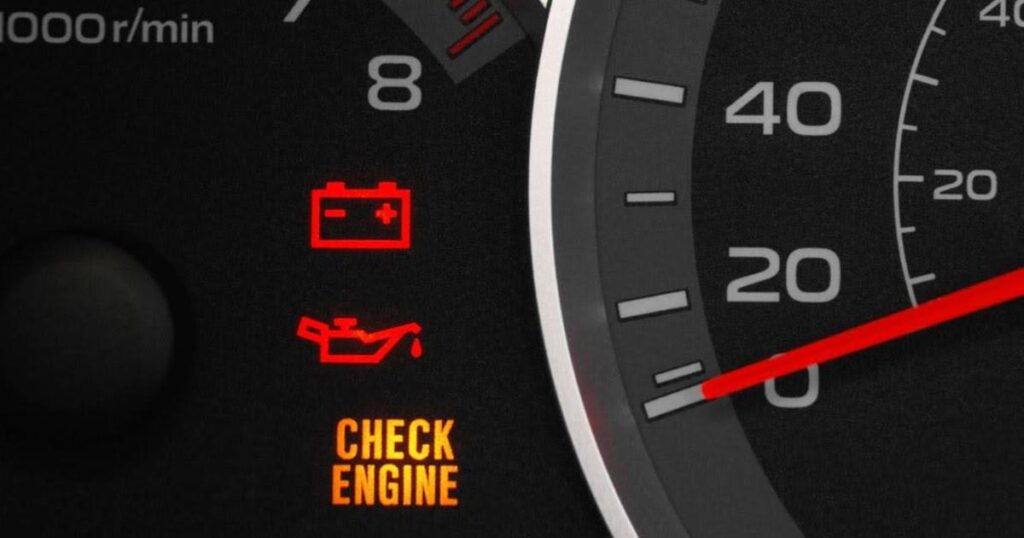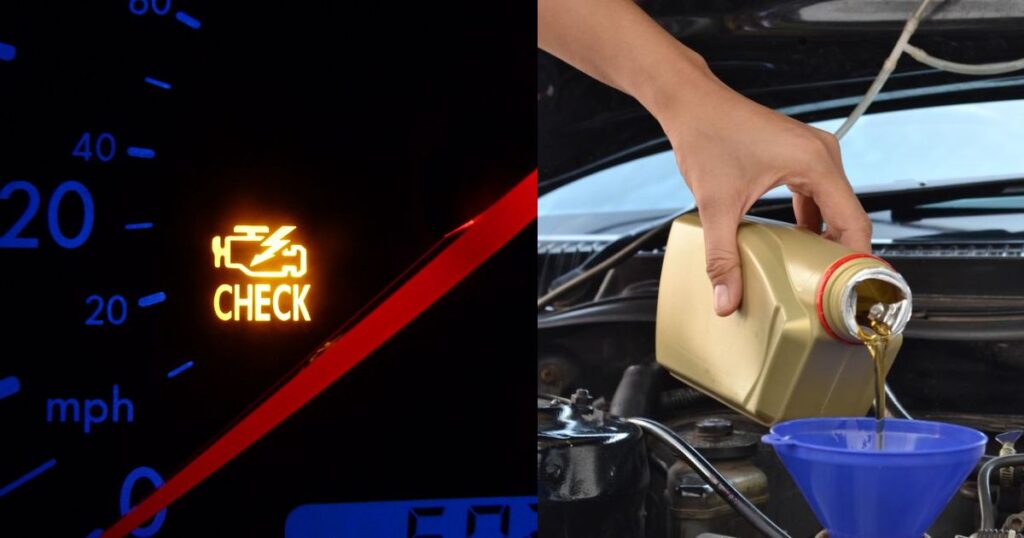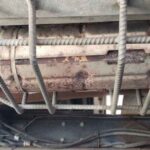Seeing the check engine light illuminate on your dashboard after an oil change can be a frustrating experience.
While it may seem like a simple maintenance task, an oil change can sometimes trigger this dreaded warning light.
In this comprehensive guide, we’ll explore the potential causes of the check engine light turning on after an oil change and provide practical solutions to get your vehicle back in top shape.
What is the Check Engine Light?
The check engine light, also known as the malfunction indicator lamp (MIL), is a critical component of your vehicle’s onboard diagnostic system. Its primary purpose is to alert you to potential issues with your engine or other related systems.
It’s important to note that the check engine light is not a specific diagnosis; it’s merely an indicator that something requires further investigation.
When the check engine light illuminates, it doesn’t necessarily mean you need to panic. However, it’s crucial to address the issue promptly to prevent any potential damage or escalation of the underlying problem.
Why is the Check Engine Light On After an Oil Change?

While an oil change seems like a routine maintenance task, it can sometimes trigger the check engine light for various reasons. Here are some common causes:
1. Loose or Damaged Sensor Connections
During an oil change, technicians may inadvertently loosen or disconnect sensors or electrical connections. These sensors play a crucial role in monitoring various engine components and systems.
If a sensor connection is loose or damaged, it can cause the engine computer to detect an issue and illuminate the check engine light.
2. Oil Residue or Spills
Oil spills or residue on sensors or electrical components can also lead to faulty readings and trigger the check engine light.
Even a small amount of oil can interfere with the proper functioning of these sensitive components, causing them to send inaccurate data to the engine computer.
3. Faulty Oil Pressure Sensor
The oil pressure sensor is responsible for monitoring the engine’s oil pressure. If this sensor malfunctions or becomes faulty, it can cause the check engine light to turn on.
A faulty oil pressure sensor may provide incorrect readings, leading the engine computer to believe there’s an issue with the oil pressure system.
4. Reprogramming Required
In some vehicles, the engine computer may require reprogramming or resetting after an oil change. This is particularly common in newer models with advanced engine management systems.
Failure to reprogram or reset the computer can cause it to detect an issue and trigger the check engine light.
5. Coincidental Issues
In some cases, the check engine light may be unrelated to the oil change itself. It’s possible that pre-existing issues or other underlying problems may have coincidentally caused the light to illuminate around the same time as the oil change.
Read More Post :
How Long Does It Really Take To Charge A Tesla?
How To Fix the Problem?
To resolve the issue of the check engine light turning on after an oil change, follow these step-by-step troubleshooting methods:
- Tighten Sensor Connections: Inspect all sensor connections and ensure they are properly tightened and secured. This includes the oil pressure sensor, mass air flow sensor, and any other relevant sensors.
- Clean Oil Residue: Carefully clean any oil residue or spills from sensors and electrical components using a suitable degreaser or cleaner. Ensure all components are dry and free from any contaminants.
- Replace Faulty Sensors: If you suspect a faulty oil pressure sensor or other sensors, it’s recommended to replace them with new ones. Consult your vehicle’s repair manual or seek professional assistance if necessary.
- Reprogram or Reset the Engine Computer: If your vehicle requires reprogramming or resetting after an oil change, follow the manufacturer’s instructions or seek assistance from a qualified technician.
- Scan for Trouble Codes: If the above steps don’t resolve the issue, use an OBD-II scanner to retrieve any trouble codes stored in the engine computer. This can provide valuable insight into the specific problem causing the check engine light to illuminate.
- Seek Professional Assistance: If you’re unable to diagnose or resolve the issue yourself, it’s advisable to seek professional assistance from a qualified mechanic or dealership service center.
How to Reset the Check Engine Light After an Oil Change?
Once you’ve addressed the underlying cause of the check engine light turning on after an oil change, you’ll need to reset the light.
The process for resetting the check engine light can vary depending on your vehicle’s make and model.
Here are some general steps:
- Resolve the Issue: Ensure you’ve properly addressed the root cause of the problem, whether it’s tightening sensor connections, cleaning oil residue, replacing faulty components, or reprogramming the engine computer.
- Disconnect the Battery: Locate your vehicle’s battery and disconnect the negative terminal. Wait for a few minutes to allow the engine computer to reset.
- Reconnect the Battery: Reconnect the negative terminal to the battery.
- Start the Vehicle: Start your vehicle and allow it to run for a few minutes to ensure the engine computer has completed its reset process.
- Check the Light: After the reset process, the check engine light should be off. If it remains on, you may need to repeat the process or seek further assistance.
Note that some vehicles may have specific reset procedures outlined in the owner’s manual or require the use of diagnostic tools or specialized equipment.
If you’re unsure about the reset process for your vehicle, consult a professional mechanic or refer to your vehicle’s repair manual.
Check engine light on after oil change how long to reset
If you’ve addressed the underlying issue and followed the reset procedure correctly, the check engine light should typically reset itself within a few driving cycles.
A driving cycle typically involves starting the vehicle from a cold start, allowing it to reach operating temperature, and driving for a certain distance or duration.
The time it takes for the check engine light to reset can vary depending on several factors, such as:
- Driving Conditions: The light may reset more quickly if you drive the vehicle under various conditions, including highway and city driving.
- Vehicle Make and Model: Different vehicles have varying reset procedures and time frames.
- Severity of the Issue: If the initial problem was more severe or complex, it may take longer for the system to fully reset and clear the check engine light.
In most cases, the check engine light should reset within a few days of normal driving if you’ve properly addressed the underlying issue.
If the light persists after several driving cycles, it’s recommended to seek professional assistance to ensure there are no remaining or unresolved problems.
Oil change check engine light reset procedure
To reset the check engine light after an oil change, follow these general steps:
- Address the Underlying Issue: Identify and resolve the root cause that triggered the check engine light, such as tightening loose connections, cleaning oil residue, or replacing faulty sensors.
- Locate the Battery: Open the hood or trunk (depending on your vehicle) and locate the battery.
- Disconnect the Battery: Carefully disconnect the negative (-) terminal of the battery using the appropriate tools.
- Wait for Reset: Leave the battery disconnected for several minutes to allow the engine computer to reset and clear any stored trouble codes.
- Reconnect the Battery: Reconnect the negative (-) terminal to the battery, ensuring a secure connection.
- Start the Vehicle: Start your vehicle and allow it to run for a few minutes to ensure the engine computer has completed its reset process.
- Check the Check Engine Light: After following the reset procedure, the check engine light should be off. If it remains on, you may need to repeat the process or seek further assistance.
Note that some vehicles may have specific reset procedures outlined in the owner’s manual or require the use of diagnostic tools or specialized equipment.
If you’re unsure about the reset process for your vehicle, consult a professional mechanic or refer to your vehicle’s repair manual.
Check engine light on after oil change but no problems
In some cases, the check engine light may illuminate after an oil change, but no apparent issues can be found. This can be frustrating, but there are a few potential explanations and next steps to consider:
- Intermittent Issues: Some problems may be intermittent, meaning they come and go, making them difficult to detect during diagnosis.
- Pending Codes: The engine computer may have detected a temporary issue and set a pending code, causing the check engine light to turn on. These pending codes may clear themselves if the issue doesn’t persist.
- Sensor Glitches: Sensors can sometimes experience momentary glitches or inconsistencies, leading the engine computer to interpret them as potential problems.
- Scan for Trouble Codes: Even if no obvious issues are present, it’s recommended to scan for trouble codes using an OBD-II scanner. These codes can provide valuable insight into the specific systems or components that triggered the check engine light.
- Seek Professional Assistance: If you’ve thoroughly inspected your vehicle and scanned for trouble codes.
Can I ignore the check engine light after an oil change?
While it may be tempting to ignore the check engine light after an oil change, especially if your vehicle seems to be running fine, it’s generally not recommended.
Here are a few reasons why you should address the check engine light promptly:
- Potential for Further Damage: Ignoring the check engine light can lead to more severe and costly issues down the road. The initial problem that triggered the light may worsen or cause damage to other components if left unaddressed.
- Decreased Fuel Efficiency: Certain issues that trigger the check engine light can negatively impact your vehicle’s fuel efficiency, causing you to spend more money on gas.
- Failed Emissions Tests: In many regions, vehicles with an illuminated check engine light will automatically fail emissions tests, which are required for registration renewals.
- Drivability Issues: While your vehicle may seem to be running fine initially, the underlying problem that caused the check engine light to turn on could eventually lead to drivability issues, such as rough idling, loss of power, or decreased performance.
- Diagnostic Trouble Codes: If you ignore the check engine light, diagnostic trouble codes related to the issue will remain stored in your vehicle’s computer system, making it more difficult to diagnose and resolve the problem in the future.
While the check engine light may not always indicate a severe problem, it’s essential to address it promptly to prevent potential complications and ensure your vehicle’s optimal performance and longevity.
What happens if I don’t fix the check engine light after an oil change?
If you choose to ignore the check engine light after an oil change and don’t address the underlying issue, several consequences may arise:
- Decreased Fuel Efficiency: Certain issues that trigger the check engine light can negatively impact your vehicle’s fuel efficiency, leading to higher fuel costs over time.
- Accelerated Component Wear: Ignoring the problem that caused the check engine light to turn on can lead to accelerated wear and tear on various engine components, potentially resulting in costly repairs or replacements.
- Increased Emissions: Unresolved issues can cause your vehicle to produce higher levels of harmful emissions, contributing to environmental pollution and potentially leading to failed emissions tests.
- Drivability Issues: Over time, the underlying problem may worsen, causing drivability issues such as rough idling, loss of power, or decreased performance, making your vehicle less reliable and potentially unsafe to drive.
- Failure of Other Systems: In some cases, the issue that triggered the check engine light may be related to or impact other systems in your vehicle, such as the transmission, brakes, or electrical systems.
- Voided Warranty Coverage: Ignoring the check engine light and failing to address the issue may void your vehicle’s warranty coverage, leaving you responsible for any future repairs related to the problem.
- Difficulty Diagnosing Future Issues: If you continue to ignore the check engine light, diagnostic trouble codes related to the initial issue will remain stored in your vehicle’s computer system, making it more challenging for mechanics to diagnose and resolve any future problems that may arise.
To avoid these potential consequences, it’s crucial to address the check engine light promptly after an oil change.
By resolving the underlying issue, you can ensure your vehicle’s optimal performance, fuel efficiency, and longevity, while also maintaining a safe and reliable driving experience.
Also Read:
Automotive Batteries: Understanding Their Hazard Classification
People Also Ask (FAQ’s)
Why did my check engine light come on after I got an oil change?
The check engine light might come on due to a sensor issue or an unrelated problem detected by the car’s system.
How long does it take the check engine light to turn off after an oil change?
The check engine light should turn off immediately after addressing the issue; if it stays on, there might be another problem.
Why would my check oil light come on after an oil change?
The check oil light may come on if there’s an oil level sensor fault, incorrect oil type, or the oil wasn’t properly filled.
Can low oil cause a check engine light to go on?
Yes, low oil levels can trigger the check engine light due to potential engine damage or other related issues.
How to fix a check engine light?
To fix a check engine light, diagnose the issue with an OBD-II scanner and address the specific problem identified.
Final Thought
Seeing the check engine light after an oil change can be alarming, but often has simple causes like loose sensors, oil residue, or a faulty oil pressure sensor. Address issues promptly by tightening connections, cleaning components, and potentially replacing sensors.
Follow the proper reset procedure for your vehicle. Ignoring the light risks further damage, decreased fuel efficiency, and failed emissions tests. Promptly diagnosing and fixing the underlying problem ensures optimal performance and prevents costlier repairs down the road.







